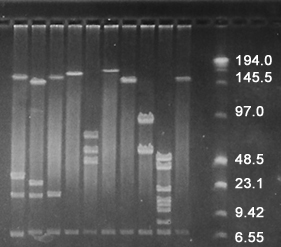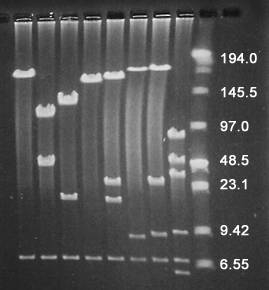We have been constructing high-quality BAC libraries since 1997. We have tremendous experience with plant, animal, yeast and bacterial genomic BAC libraries. Some of our clients include Agriculture Canada, Pioneer Hi-Bred Int'l (DuPont), Bayer, Cargill and the Max Planck Institutes in Germany. We guarantee a quick turnaround-time, unbeatable pricing and large inserts.
References are proudly provided.
We also offer BAC library construction in custom and shuttle vectors! Please contact areti@biost.com
POOLED BAC LIBRARY CONSTRUCTION
A pooled BAC library is an invaluable tool for PCR-screening. It allows for the easy retrieval of BAC clones of interest. This type of library is especially useful when genome size is large and creating an arrayed library is cost-prohibitive.
Highlights
- We typically construct a minimum 5X BAC library which provides a 99.3% probability of finding the target sequence. Additional coverage and 2-enzyme digestion is available (additional fee). We pride ourselves in tailoring our services to suit our client's needs.
- BAC clones are then pooled and distributed in 96-well plates. For example, a BAC library created from a 3Gb species will consist of at least 125,000 BAC clones (AIS of 125kb) distributed into 3 x 96-well plates. Each well will contain about 400-500 original BAC clones.
- Coverage is guaranteed. Amount of clones received is based on a guaranteed coverage and 120Kb average insert size.
- HMW DNA isolation and QC by HMW DNA enzymatic digestion are included.
- FREE and unlimited storage of Pooled BAC libraries at our facilities for future screening!
Related Services
- Screening: The pooled BAC library can be PCR-screened using client-provided PCR primer pair(s) which specifically amplifies a segment in the target area. Price per screening is dependent on genome size. Client can decided the number of positive BAC clones he wishes to purchase.
-
Row and Column Pools derived from Pooled BAC library: We can also provide the following pools which will allow client to immediately begin screening.
- Row pools from Superpool plates: isolated DNA.
- Column pools from Superpool plates: isolated DNA.
Advantages
The pooled BAC library can be screened hundreds of times and stored indefinitely.Our pooling method keeps the library in a compact format which is very easy to store.Copies can be easily made and economically shipped to collaborators worldwide.
Drawback
The only disadvantage to this type of library is that it cannot be used for physical mapping or full-genome sequencing.
Our strengths
- We guarantee coverage.
- High average insert and even insert size distribution (see Graph 1 below).
- We perform HMW DNA extraction at our facilities.
- We have experience with plant, fungal, bacterial and animal libraries.
- We have extensive experience with GC-rich organisms and marine bacteria.
- Our arrayed BAC libraries are shipped in bar-coded microplates.
- We have extensive experience shipping worldwide.
- Shipment temperature of non-arrayed libraries is always monitored using a BLUE FLAG Temperature Data logger.
- We provide technical support.
- BAC libraries are the client's property and are never used internally, sold or distributed.
- We provide references
Table 1: A few libraries constructed in the past with obtained average insert sizes.
| Starting material | Insert size |
| Musmusculus | 180 Kb |
| Zea mays | 150 Kb |
| P. brassicacearum | 160 Kb |
| P. omnivore | 185 Kb |
| Arabidopsis thaliana | 150 Kb |
| Homo sapiens | 215 Kb |
Figure 1: PFG following NotI digestion of insect BAC clones ( Mamestra configurata) with an average insert size of 178Kb

Figure 2: PFG following NotI digestion of fungal BAC clones P. omnivora) with an average insert size of 185Kb.

Graph 1: BAC clone insert size distribution (average of 140Kb) of a Soybean BAC library (Glycine max).

Scholar articles for BAC library construction
- https://www.nature.com/articles/ncomms4706?message-global=remove
- https://link.springer.com/article/10.1007/s00122-016-2740-0
- https://bmcplantbiol.biomedcentral.com/articles/10.1186/s12870-019-1766-2
- https://www.sciencedirect.com/science/article/pii/S0197458014008252
- https://bmcgenomics.biomedcentral.com/articles/10.1186/1471-2164-12-217
- https://nph.onlinelibrary.wiley.com/doi/full/10.1111/j.1469-8137.2012.04128.x
- https://link.springer.com/article/10.1007/s11248-012-9646-7
- https://academic.oup.com/gbe/article/doi/10.1093/gbe/evq047/577231
Importance of a BAC library
BAC libraries are essential elements in doing large-scale genome research such as screening for genes of target, biosynthetic gene cluster cloning, transgene identification, gene/gene cluster functional analyses, physical mapping and genome sequencing. Bacterial artificial chromosome (BAC) cloning technology was developed in the early 1990s and quickly gained popularity among scientists whose requirement included developing a thorough understanding of gene network topology based effects, with particular emphasis on gene dosage and gene cassette orientation. Although this technology was developed much later than Yeast Artificial Chromosome (YAC) and cosmid/fosmid based genome library cloning technologies it soon became popular and tractable because of the technical advantages offered by BAC based cloning over YAC and cosmid/fosmid library cloning systems:1. Larger insert sizes (>100 kb).
- Larger insert sizes (>100 kb).
- More stable than YAC clones. YAC clones can be unstable and un-clonable.
- BAC DNA can be easily isolated (supercoiled BAC DNA versus linear YAC DNA).
The other important applications of BAC library construction are in large-scale physical mapping and genomic sequencing. Here are some examples of its major applications:
Library screening
BAC libraries enable rapid screening and isolation of target BAC clones.
Isolation of gene clusters for biosynthetic pathways
A BAC library can be used to screen for gene pathways in microorganisms derived from soil and marine environments. This enables discovery of new compounds in drug discovery (mainly antibiotics), plant genetics and microbial metabolic research. Finding novel enzymes is another application that is important to the industrial microbiology sector.
Preparation of FISH probes
FISH (Fluorescence In Situ Hybridization) probes are commonly made from BAC clones. This technique is useful in the detection of chromosomal rearrangements, deletions and aneusomies.
Complementation for map-based gene cloning using binary vector in plants
A BAC library can be used to interrogate the genetic structure of plant genomes as well as mutant genotype analysis using complementation techniques. This endows the scientist with a reliable tool to study global gene expression in plant species and to isolate individual genes.
Physical maps and complete genome sequencing
BAC libraries and isolated overlapping BAC clones are important tools for genome sequencing and contig assembly.

